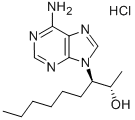EHNA (51350-19-7) inhibits phosphodiesterase 2 (PDE2) (IC50 = 0.8 – 5.5 μM in a variety of tissues and species) over PDE1, PDE3, or PDE4 (IC50 values > 100 μM).1,2 It also inhibits adenosine deaminase (ADA), IC50 = 1.2 and 1.5 μM in human RBCs and astrocytoma cells, respectively3, which may be responsible for its ability to induce apoptosis in malignant pleural mesothelioma cell lines4. Because it blocks breakdown of adenosine to inosine and hypoxanthine, EHNA prevents formation of free radical substrates, protecting against cardiac reperfusion-mediated injury.5 It inhibits differentiation and maintains expression of pluripotency markers in hESCs, but not through inhibition of PDEs or ADA.6
A potent inhibitor of phosphodiesterase II (PDE II) (IC50=800nM). Does ot inhibit other PDE isozymes (IC50>100uM). Inhibits the retrograde transport motor, dynein. Also inhibits adenosine deaminase (Ki=4nM)
9-erythro-(2-Hydroxyl-3-nonyl)adenine is an intermediate in the synthesis of potent inhibitor of phosphodiesterase II.
ChEBI: (2R,3S)-EHNA is eHNA of absolute configuration 2R,3S. Selective inhibitor of cGMP-stimulated phosphodiesterase (PDE2) (IC50 = 0.8 - 4 mM). Also a potent inhibitor of adenosine deaminase. It has a role as an EC 3.5.4.4 (adenosine deaminase) inhibitor and an EC 3.1.4.* (phosphoric diester hydrolase) inhibitor. It is a conjugate base of a (2R,3S)-EHNA(1+). It is an enantiomer of a (2S,3R)-EHNA.
Selective inhibitor of cGMP-stimulated phosphodiesterase (PDE2) (IC 50 = 0.8 - 4 mM). Also a potent inhibitor of adenosine deaminase.
Podzuweit et al. (1995), Isoenzyme selective inhibition of cGMP-stimulated cyclic nucleotide phosphodiesterases by erythron-9-(2-hydroxy-3-nonyl) adenine; Cell Signal., 7 733
Méry et al. (1995), Erythro-9-(2-hydroxy-3-nonyl)adenine inhibits cyclic GMP-stimulated phosphodiesterase in isolated cardiac myocytes; Mol. Pharmacol., 48 121
Barankiewicz et al. (1997), Regulation of adenosine concentration and cytoprotective effects of novel reversible adenosine deaminase inhibitors; J. Pharmacol. Exp. Ther., 283 1230
Nakajima et al. (2015), Adenosine deaminase inhibitor EHNA exhibits a potent anticancer effect against malignant pleural mesothelioma; Cell Physiol. Biochem., 35 51
Abd-Elfattah and Wechsler (1994), Separation between ischemic and reperfusion injury by site specific entrapment of endogenous adenosine and inosine using NBMPR and EHNA; Card. Surg., 9 387
Burton et al. (2010), Erythro-9-(2-hydroxy-3-nonyl)adenine(EHNA) blocks differentiation and maintains the expression of pluripotency markers in human embryonic stem cells; Biochem. J., 432 575
